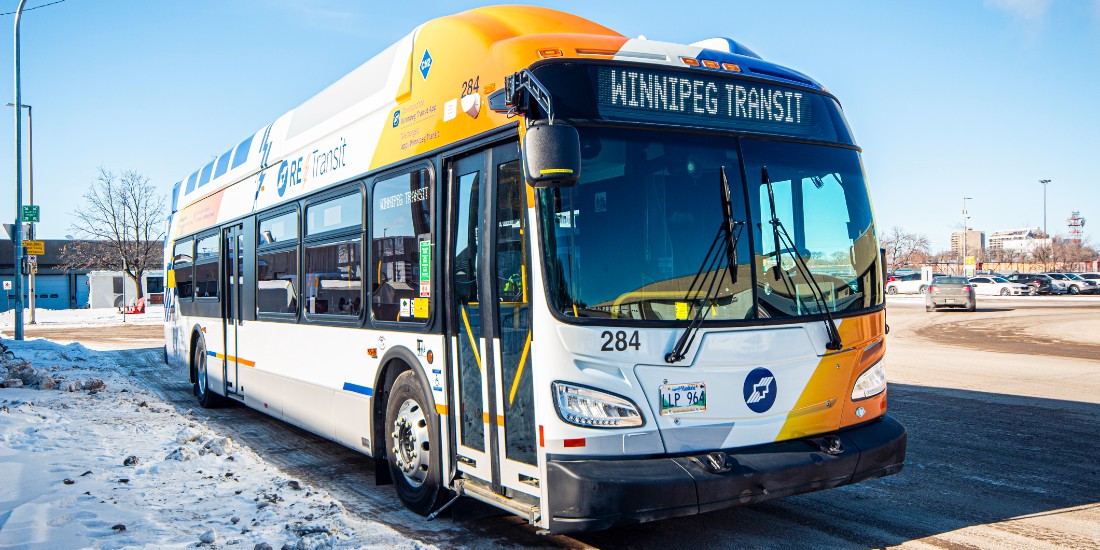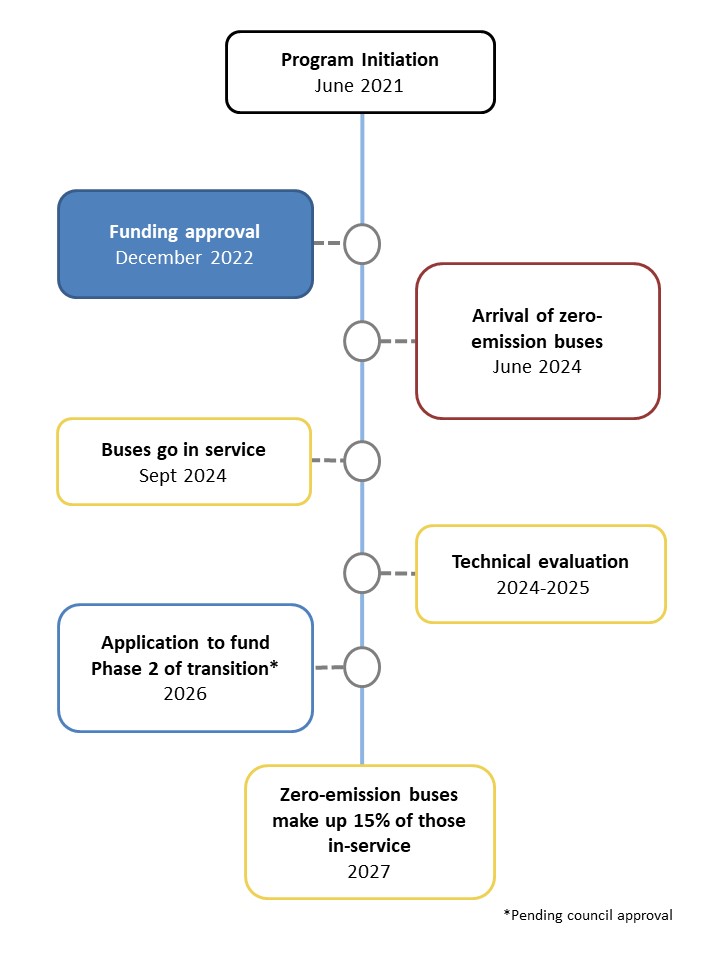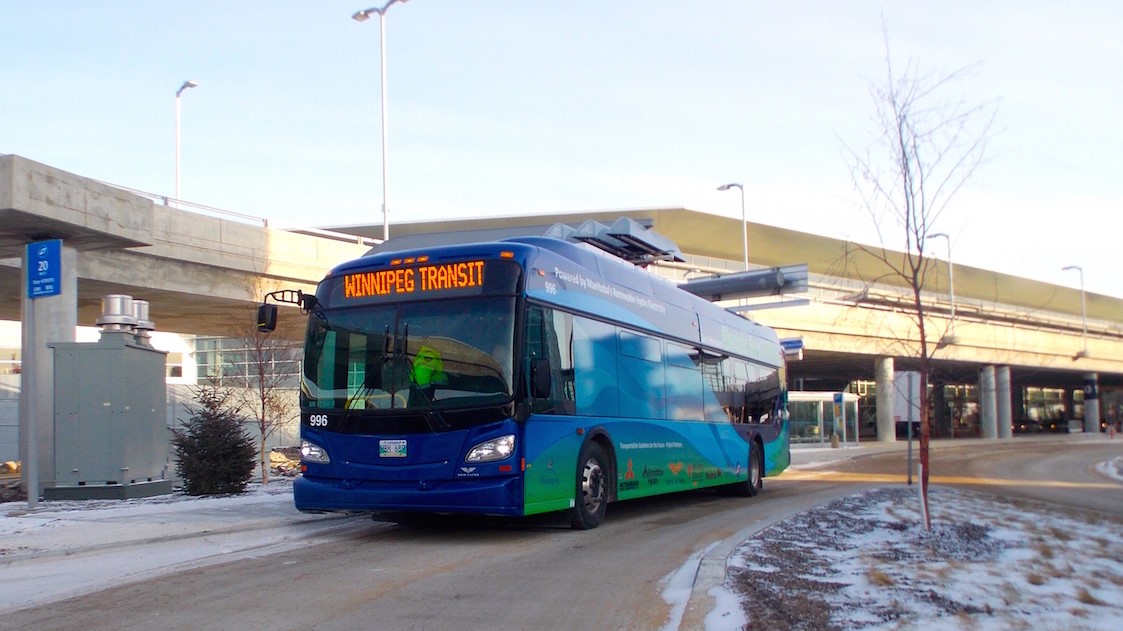Transition to Zero-Emission
FrançaisThe Next Step to Electrifying the Winnipeg Transit Fleet
As cities across North America embrace a new vision for sustainable transportation made possible by recent advances in battery-electric bus technology, approximately $280 million is being invested to make that vision a reality in Winnipeg. More than just purchasing zero-emission buses (ZEB), to transition to a fully electric fleet will require an overhaul of transit operations, every facet of which was designed for diesel.
The Transition to Zero-Emission Bus Program is now underway. The program builds on a successful electric bus demonstration, and the work of a 2015-16 task force that determined more information was needed to understand how to transition to an electric fleet, and what changes would be needed for planning, operation and maintenance based on electric bus charging technologies. The program follows the path set by the 2021 Transition to Zero-Emission Bus Study, starting with the purchase of a mixed test fleet of 16 zero-emission buses.
First zero-emission bus unveiled

The first zero-emission bus has joined the fleet. Winnipeg Transit welcomed the 40-foot fuel-cell battery-electric bus to its Fort Rouge Garage at the end of January 2025. It is the first of 16 ZEBs expected this spring. This initial Transition to Zero-Emission Bus Program fleet will consist of:
- Four 40-foot and four 60-foot fuel-cell battery-electric buses
- Four 40-foot and four 60-foot battery-electric buses
Winnipeggers can expect to see the first ZEBs on roads as early as mid-March. They will be in limited service in April following the spring schedule change. Winnipeg will be the first city in Canada to put 60-foot ZEBs into service.
Winnipeg Transit’s second order of ZEBs – 24 in total – is expected in early 2026.
- Timeline
- First ZEB unveiled
- Background
- Transition to Zero-Emission Program
- Documents
- FAQs
Project Timeline

First ZEB unveiled
The first zero-emission bus (ZEB) has joined our fleet.
Winnipeg Transit welcomed the 40-foot fuel-cell battery-electric bus to its Fort Rouge Garage at the end of January 2025. It is the first of 16 ZEBs expected this spring. This initial Transition to Zero-Emission Bus Program fleet will consist of:
- Four 40-foot and four 60-foot fuel-cell battery-electric buses
- Four 40-foot and four 60-foot battery-electric buses
Under this program, Winnipeg Transit is receiving up to $280.3M in funding through the Investing in Canada Infrastructure Program (ICIP). This funding will be used to purchase 90 ZEBs.
Winnipeggers can expect to see the first ZEBs on roads as early as mid-March. They will be in limited service in April following the spring schedule change. Winnipeg will be the first city in Canada to put 60-foot ZEBs into service. Each bus added to the fleet will cut approximately 62 tonnes of greenhouse gas emissions annually.
The buses are also sporting a brand-new design combining different Winnipeg Transit eras. It features the geometry of the Flying T logo with the classic orange and modern blue colours.
All 16 buses will complete in- and out-of-service testing. Testing will look at a variety of factors, including (but not limited to):
- Battery health
- Energy consumption
- Operating costs
Testing will also look at which zero-emission technology is most effective in Winnipeg’s climate. Battery-electric buses recharge by connecting to a charger and drive for 10 to 15 hours. Fuel-cell battery-electric buses recharge with hydrogen and drive for up to 24 hours.
All information gathered will help determine the future steps in electrification.
Winnipeg Transit’s second order of ZEBs – 24 in total – is expected in early 2026.
Background
A decade of development in Manitoba
The Transition to Zero Emission Bus Program builds on trailblazing local efforts to develop and test electric bus technology for use in a cold-climate province. Electric bus activities began in Manitoba in 2010, when the Province of Manitoba signed an MOU with Mitsubishi Heavy Industries to develop and demonstrate electric buses.
In 2012, a demonstration began using a prototype bus built with Mitsubishi’s battery technology and Manitoba bus manufacturer New Flyer’s advanced Xcelsior glider platform. The bus was used to shuttle Manitoba Hydro employees between its headquarters on Portage Avenue and a location on Taylor Avenue, where a rapid-charger was temporarily located.
Electric buses go into service on Route 20 Watt-Academy
Following the first demonstration, New Flyer applied for funding from Sustainable Development Technology Canada to expand the project and develop four additional prototype buses for demonstration.
The City of Winnipeg partnered with New Flyer for the demonstration, which saw the buses being operated in on-route service with Winnipeg Transit for four years beginning in 2014. The buses operated on a two-hour route, Route 20 Watt-Academy, and utilized an on-route rapid charging system installed at the James Armstrong Richardson International Airport. The demonstration provided key insights into the construction, operation, and maintenance of battery electric buses, and the prototypes were retired and returned to the manufacturer in 2018.

Task force forms
Recognizing the success of the ongoing demonstration, in November 2015 the City of Winnipeg and the provincial government announced the formation of a joint task force on transit electrification, which included representatives from Manitoba Hydro, New Flyer, and Red River College.
It summarized its findings in July 2016 in a report that outlined a number of benefits to new electric technology, including reduced fuel costs, reduced maintenance costs, as well as reduced GHG emissions and noise.
The task force concluded that while diesel buses were less costly than electric buses overall, the declining cost of batteries and the uncertain but likely-to-increase cost of diesel meant there could be a longer-term economic advantage to electric buses.
It also found there would be a significant cost to integrate electric buses into current transit networks, and while studies in North America had focused on small-scale testing, more information was needed to determine how to integrate electric buses on a larger scale. It was recommended that electrification be pursued in a staged approach; first deploying 12 to 20 electric buses, increasing to 120 to 200 buses, then full electrification.
Transition to Zero-Emission Bus Study
The task force noted the demonstration in Winnipeg as one of the most advanced in the world, and the practical experience gained here made the location ideal for deploying electric buses on a larger scale.
As part of its 2019 budget, Council approved a $1 million investment to study how to transform a system of planning, operation, and maintenance designed around diesel buses to one around zero-emission buses, in order to begin the transition.
The Transition to Zero Emission: Technical Evaluation Report, and the accompanying Class 3 and Class 4 cost estimates, came as the result of the study.
Transit currently retires 30-32 end-of-life buses annually and replaces them with purchases made through its Transit Bus Replacement Program. Transit is now proposing that program be replaced with a new one, the Transition to Zero-Emission Program, which includes purchasing approximately 100 zero-emission buses between 2022-2027.
Transition to Zero-Emission Program
The proposed plan
With the Transition to Zero Emission: Technical Evaluation, Winnipeg Transit established a clear path to begin its transition to a zero-emission fleet.
In it, Transit recommended its existing Transit Bus Replacement Program be replaced with the proposed Transition to Zero-Emission Bus Program, to help to ensure a smooth transition. The goal of the new program is to set the direction for establishing a zero-emission fleet, subject to Council approval and securing funding sources.
Under the Transition to Zero-Emission Bus Program, Transit received funding through the Investing in Canada Program (ICIP) towards the purchase of zero-emission buses.
By 2027, 15 percent of Winnipeg Transit service will be provided by the zero-emission fleet, at an estimated cost of $280.4 million. While the total cost will be higher than the projected cost to replace buses with diesel, with ICIP funding the City’s share of the cost will be lower, resulting in incremental savings of $10 million.
The first project under the Transition to Zero-Emission Bus Program is the Transition Fleet Project, consisting of the purchase of an initial, mixed test fleet of 16 long-range zero-emission buses. The buses will add capacity to Winnipeg Transit existing fleet and this will allow Transit to collect data to assist with all aspects of future planning and decision-making.
The initial test fleet and associated infrastructure is estimated to cost approximately $38.3 million The City’s share of that cost is approximately $11.4 million, with provincial and federal governments providing the rest via the Investing in Canada Infrastructure Program (ICIP).
Starting in 2023, each new zero-emissions bus purchase will enable Winnipeg Transit to retire the equivalent number of diesel buses.
Because the Brandon Garage and Fort Rouge Garage only have electrical service capacity to support approximately 100 zero-emission buses, by 2027, Transit will need further investment and a dedicated garage to support continued growth of the zero-emission fleet. A replacement for the North Garage is being designed with this in mind.
To ensure the transition continues beyond the Transition Fleet Project, Winnipeg Transit is developing a Transition to Zero Emission Roll-out Plan as a capital investment roadmap for the Transitioning to Zero Emission Bus Program beyond 2027. The report will consider future costs relating to bus procurement; charging and fueling infrastructure; electrical utility updates; energy resiliency; facility retrofits; and tooling and equipment purchases.
This report focuses on more specific details of the City’s transition plan such as vehicle procurement schedule; fleet distribution across multiple facilities; refueling strategy; timing of facility and other infrastructure projects; economic impact assessment; and identifying program risk & opportunities including the potential accelerate the timeline for completing the transition and to explore advancing and emerging technologies to improve safety, reduce traffic congestion, decrease travel time, and increase the ridership experience.
The Benefits
- Compared to diesel buses, zero-emission buses have lower annual operating costs.
- Each new zero-emission bus added to the fleet will eliminate nearly 62 tonnes of greenhouse gas emissions annually.
- The transition plan will allow Transit to meet its target set out in Winnipeg’s Climate Action Plan.
- Transit will power its zero-emission fleet using Manitoba’s clean hydro-electricity, reducing reliance on imported fossil fuels.
If fleet replacement begins in 2024 and continues as proposed:
- By 2030, 30 percent of transit service will be provided by zero-emission.
- By 2045 or potentially sooner, the transition will be complete.
Documents
| Document Name | Date | Type |
|---|---|---|
| The Future is Ahead of You: Summary Report of the Manitoba Government and City of Winnipeg Joint Task Force on Transit Electrification | July 2016 | Report |
| Transition to Zero Emission: Technical Evaluation Report | February 5, 2021 | Report |
| Transition to Zero Emission: Technical Evaluation | February 5, 2021 | Report |
FAQs
The test fleet will begin operating as early as 2024.
Transit currently retires 30-32 end-of-life buses annually and replaces them with purchases made through its Transit Bus Replacement Program. That program is being replaced with a new one, the Transition to Zero-Emission Bus Program. The first project under the new program would be the Transition Fleet Project, which would involve the purchased of a mixed-test fleet of 16 zero-emission buses.
Transit is recommending the Transition Fleet Project consist of an initial test fleet of 16 buses:
- Four 40-foot long-range battery electric buses (BEBs)
- Four 60-foot long-range BEBs
- Four 40-foot fuel-cell battery electric buses (FC-BEBs)
- Four 60-foot FC-BEBs
Long-range BEBs can operate for up to 15 hours between charges, while FC-BEBs have an onboard battery charger allowing the bus to operate for up to 24 hours between fueling with hydrogen – generated using energy from electricity in Manitoba.
FCBEBs would be more similar to diesel to plan for and operate. They fuel in minutes rather than hours, they have improved cold-weather efficiency, and greater resiliency in the event of a long-term power outage.
The proposed mix of 40 and 60-foot buses will help Transit evaluate the various sizes that would be needed to fully transition the fleet to zero-emission.
The mixed-test fleet will allow Transit to gather data to help determine which technologies will work best for a full-fleet transition in Winnipeg.
While the initial cost will be higher, investing approximately $38.3 in a mixed BEB/FC-BEB test fleet puts us in the best position to achieve significant savings when fleet-wide electrification is pursued.
Each technology has advantages and disadvantages and both technologies may be needed as Transit transitions to a fully electric fleet.
What we learn from the operation of the test fleet will allow us to refine our plans and ensure we go forward with the best technology for our route network and operations.
The manufacturer of the buses is New Flyer, the successful applicant in an open procurement process.
Not immediately, but Winnipeg Transit’s last diesel bus order is planned for 2025 delivery.
Like with all fuels, there is some degree of risk associated with hydrogen. However, this technology is mature and has achieved a high level of safety through design validation, testing and certification.
Additionally, with the low-cost, green electricity available in Manitoba, the cost to produce hydrogen for fuelling would be competitive or lower than diesel.
The estimated capital costs of the first phase of the proposed Transition to Zero-Emission Bus Program – a mixed fleet of approximately 100zero-emission buses and associated charging/refueling infrastructure – is approximately $280.4 million. While this is greater than the projected cost to continue status quo purchases of diesel buses, the City’s share of the costs is estimated to be lower under the Investing in Canada Infrastructure program. The City anticipates an incremental savings of $10 million while freeing up Federal Gas Tax contributions for other Transit projects.
Additional investments – including an infrastructure investment in a replacement for Transit’s North Garage that would be designed to support zero-emission buses – will be required beyond the first 100 buses.
Theses buses were owned by New Flyer and leased to Winnipeg Transit during the demonstration. The prototype technology used on these buses was not adequate for long-term operating in Transit’s fleet. The buses were returned to the manufacturer when the demonstration ended in 2018.
Transitioning to a zero-emission fleet will take much more than just purchasing buses, and there were many factors to consider. To ensure we’re making the smartest investments possible, Winnipeg Transit has carefully evaluated all forms of the technology and our capacity to support them. We looked at the impact on everything we do, including route planning, dispatching, maintenance planning, refueling/charging and human resources/training. Our assessment also looked at the lifecycle cost, performance and safety of zero-emission buses and their refueling infrastructure, and compared these factors to diesel.
The Transition to Zero-Emission: Technical Evaluation establishes a clear path for Transit to begin its transition to a zero-emission fleet.
- Transit currently utilizes fossil fuels in the propulsion of transit buses which contributes significantly to greenhouse gas emissions.
- The proposed Transition to Zero-Emission Bus Program and Transition Fleet Project will put Transit on track to having a 100% zero-emission fleet ahead of the 2050 target set by Winnipeg’s Climate Change Action Plan.
- Each new zero-emission bus added to the fleet eliminates nearly 62 tonnes of GHG tailpipe emission manually.
- Transit will power its zero-emission fleet using Manitoba’s clean hydro-electricity, reducing reliance on imported fossil fuels.
Initially, charging infrastructure for battery-electric buses will be located in Brandon Garage, and refueling infrastructure for fuel-cell battery electric buses will be located in Fort Rouge Garage. To ensure the transition to a fully electric fleet is able to continue, Transit is in the process of designing a replacement for its North Garage, to be constructed prior to 2027.
Plans for Transit’s transition to zero-emission are being developed to support the proposed network changes in Winnipeg Transit Master Plan, including the recommendation to include 60-foot buses in the test fleet, as the larger buses will be suitable for rapid, frequent and direct lines that make up WTMP’s primary network.



